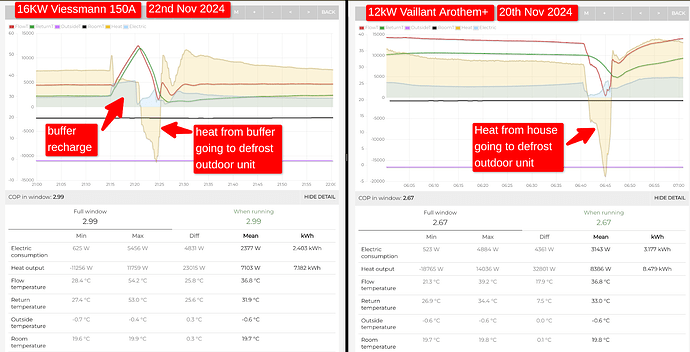It’s fascinating how Viessmann ASHPs handle defrost. In this analysis, I will compare the defrost characteristics of a Viessmann ASHP system with a similar Vaillant system.
I’ve chosen to compare two high performing system on https://heatpumpmonitor.org:
-
16kW Viessmann 150A in Clunbury, Shropshire installed by Josh Stead: https://heatpumpmonitor.org/system/view?id=319
-
12kW Vaillant Arothem+ installed by Heat Geek in Ashstead, Surry https://heatpumpmonitor.org/system/view?id=196
Both systems are installed in properties with similar heat loss (around 12kW)* and similar design temperature (40-45C). Both heat pumps use R290 refrigerant.
At -3C outside the 16kW Viessmann 150A can output 12.9kW and the 12kW Vaillant Arothem+ can output 14kW according to manufacturer data**.
While these two heat pumps have quite similar specs, they both have a very different approach to handle defrost:
-
Viessmann use an internal defrost buffer inside the indoor unit which is heated up prior to defrost to enable the defrost cycle to be completed without drawing much heat from the emitter circuit
-
Vaillant use the standard defrost technique of taking heat energy from the house emitter system to complete a defrost.
Important: Keep in mind when looking at this data, that while these two heat pumps are relatively similar, there will obviously be differences in the heating systems and control settings between the systems which may affect defrost performance. Also, we don’t have a record of the outdoor humidity during defrost.
Here’s a comparison of a defrost cycle under very similar conditions, 0.6C outside, 36C flow temp:
| Viessmann | Vaillant | |
|---|---|---|
| Length of defrost cycle - to regain same flow temp | 14min | 14min |
| Electrical energy used | 0.6kWh | 0.14kWh |
| Heat lost from house | 0W (presumed) | -0.76kWh |
| Average COP between defrost | 3.86 | 3.05 |
| Electrical energy required to regain lost heat | 0kWh | 0.25kWh |
| Total electrical energy used for defrost | 0.6kWh | 0.39kW |
| Average 24Hr cold weather COP (average 3.4C) | 4.03 | 3.35 |
Viessmann Defrost
The Viessmann method of heating up the internal defrost buffer uses more electricity initially to raise the flow temperature from 35C to 54C to recharge the internal buffer. Delivering a high flow temperature results in low COP for this 5 min buffer recharging period, COP 1.28 in this example. It’s interesting to note that in this example Viessmann does not use the resistive electric booster heater, the buffer is heated up just using the compressor. It would be interesting to know under what criteria does the Viessmann activate the resistive electric booster heater?
Vaillant Defrost
During this defrost example, Vaillant extracted 0.76kWh of heat from the house heating circuit, this resulted in a negative COP of -5 for a short period during defrost. Extracting heat from the heating circuit, resulting in a 16C drop in the flow temperature. Vaillant then needs to work harder to regain the lost heat back into the property. Taking into account having to regain the heat lost, the amount of electrical energy used for the defrost is very similar, 0.6kWh for the Viessmann and 0.4kWh for the Vaillant.
Comparison / Discussion
The main advantage of the Viessmann method is that no heat is lost from the heating circuit and the defrost cycle is not dependent on the heating circuit having enough volume available to provide sufficient energy to defrost e.g if a number of TRVS or zones are switched off the Vaillant may not be able to fully defrost leading to a defrost death spiral and eventual system failure. Although with good open-loop system design and or a volumiser this risk can be mitigated. It’s possible Viessmann may result in a slight improvement in customer comfort, since radiators won’t get colder to the touch during a defrost.
Another thing to note is that the Viessmann system seems to require far fewer defrosts compared to Vaillant system, this could be due to the Viessmann system having a lower heat demand, see ** below.
Conclusion
Both heat pumps are able to defrost in an effective way and both heat pumps average fantastic COP.
Comparing the two systems over a 24hr period with the same outdoor temperature which includes a number of defrost cycles the Viessmann seems to average a higher COP, this higher COP seems to be due to very efficient normal steady state running rather than specifically defrost performance.
This is only a single example, more example comparisons are needed to draw a definitive conclusion
* Vaillant output capacity in colder weather including the effect of defrost has been tested to be lower than the manufacturer’s stated output, see: Vaillant maximum output capacity testing. We don’t have much data on Viessmann maximum output capacity.
** The heatpumpmonitor.org Heat Demand Tool indicates that the actual heat loss of Clunbury, Shropshire is around 7.7kW at -3C and the actual heat loss of Ashstead, Surry is around 12.9kW.


